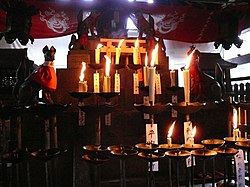Terminology
A number of alternative terms have been used instead of ethnic religion. Another term that is often used is folk religion . While ethnic religion and folk religion have overlapping uses, the latter term implies "the appropriation of religious beliefs and practices at a popular level." [4] The term folk religion can therefore be used to speak of certain Chinese and African religions, but can also refer to popular expressions of more multi-national and institutionalized religions such as Folk Christianity or Folk Islam. [5] [6]
In Western contexts, a variety of terms are also employed. In the United States and Canada, a popular alternative term has been nature religion . [7] Some neopagan movements, especially in Europe, have adopted ethnic religion as their preferred term, aligning themselves with ethnology. This notably includes the European Congress of Ethnic Religions, which chose its name after a day-long discussion in 1998, where most participants expressed that pagan contained too many negative connotations and ethnic better described the root of their traditions in particular nations. In the English-language popular and scholarly discourse Paganism , with a capital P, has become an accepted term. [9]
This page is based on this
Wikipedia article Text is available under the
CC BY-SA 4.0 license; additional terms may apply.
Images, videos and audio are available under their respective licenses.
